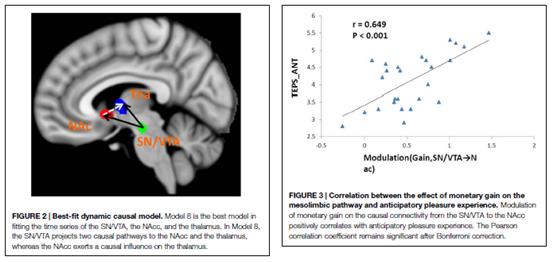
Deficits in hedonic capacity, namely anhedonia, are often found in patients with neuropsychiatric disorders such as schizophrenia. Recent research suggests that hedonic capacity is consisted of at least two phases, the consummatory and anticipatory pleasure. The former phase involves the in-the-moment experience of pleasure, whereas the latter phase involves the prediction of pleasure in the future. Convergent evidence suggests the important role of the mesolimbic pathway in anticipatory rewards. However, it is still unclear about the underlying mechanism of the interactions among different sub-regions, e.g., how does the nucleus accumbus and the thalamus contribute to an effective connectivity for anticipation of pleasure and reward in healthy people.
Dr. CHAN Raymond and his team from the Institute of Psychology of Chinese Academy of Sciences have attempted to examine the underlying neural mechanism of reward anticipation. Specifically, they examined the reward-related network for anticipating monetary reward using a Dynamic Causal Modeling (DCM) method. DCM is specifically designed to examine the causality between hemodynamic activation of predefined brain regions. Comparing to the traditional functional connectivity method which is based on the correlation analysis, the DCM helps people clarify the directions in a brain circuit.
The researchers recruited 26 healthy volunteers and administered a monetary incentive delay task, which was specifically designed to capture anticipation and consummation of monetary reward. The results showed that the best-fit network involved the right substantia nigra / ventral tegmental area (SN/VTA), the right nucleus accumbens (NAcc) and the right thalamus, which were all activated during anticipation of monetary gain and loss. The SN/VTA directly activated the NAcc and the thalamus.
Dr. CHAN’s team also found that monetary gain modulated the connectivity from the SN/VTA to the NAcc and this was significantly correlated with subjective anticipatory pleasure. Taken together, these findings suggest that activity in the mesolimbic pathway during the anticipation of monetary reward could to some extent be predicted by subjective anticipatory pleasure. The findings shed light on the understanding of the underlying impaired neural mechanisms associated with anhedonia observed in schizophrenia and other related neuropsychiatric disorders.
This study was supported by grants from the “Strategic Priority Research Program (B)” of the Chinese Academy of Sciences, the National Science Fund China, and the Beijing Training Project for Leading Talents in S&T.
The paper is available online in Frontiers in Behavioral Neuroscience.

Figure: Best-fit dynamic causal model and correlation between the effect of monetary gain on the mesolimbic pathway and anticipatory pleasure experience. (Image by Institute of Psychology)

86-10-68597521 (day)
86-10-68597289 (night)

52 Sanlihe Rd., Xicheng District,
Beijing, China (100864)

